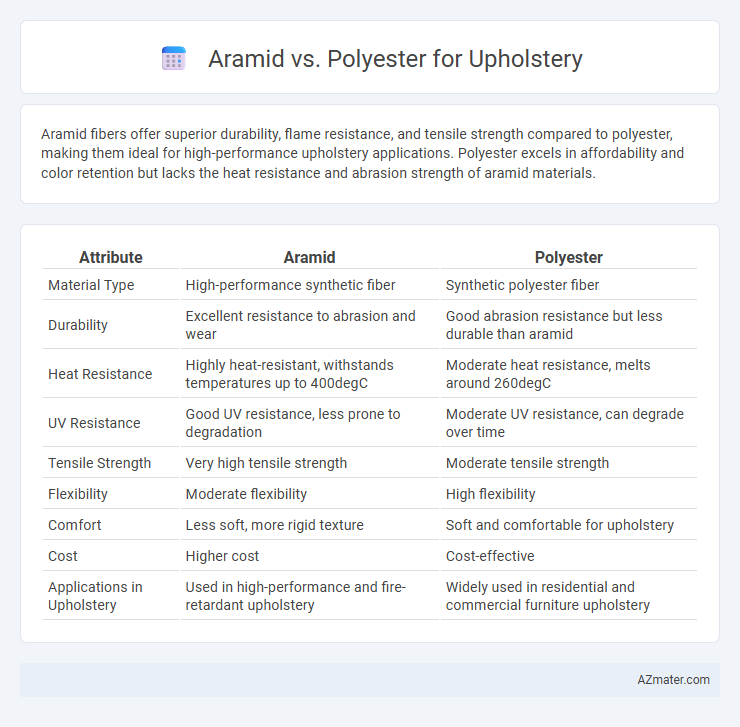Aramid fibers offer superior durability, flame resistance, and tensile strength compared to polyester, making them ideal for high-performance upholstery applications. Polyester excels in affordability and color retention but lacks the heat resistance and abrasion strength of aramid materials.
Table of Comparison
| Attribute | Aramid | Polyester |
|---|---|---|
| Material Type | High-performance synthetic fiber | Synthetic polyester fiber |
| Durability | Excellent resistance to abrasion and wear | Good abrasion resistance but less durable than aramid |
| Heat Resistance | Highly heat-resistant, withstands temperatures up to 400degC | Moderate heat resistance, melts around 260degC |
| UV Resistance | Good UV resistance, less prone to degradation | Moderate UV resistance, can degrade over time |
| Tensile Strength | Very high tensile strength | Moderate tensile strength |
| Flexibility | Moderate flexibility | High flexibility |
| Comfort | Less soft, more rigid texture | Soft and comfortable for upholstery |
| Cost | Higher cost | Cost-effective |
| Applications in Upholstery | Used in high-performance and fire-retardant upholstery | Widely used in residential and commercial furniture upholstery |
Introduction to Aramid and Polyester Upholstery Fabrics
Aramid upholstery fabrics, known for their exceptional strength and heat resistance, offer durability and safety in high-performance furniture applications. Polyester fabrics provide versatility, affordability, and vibrant color options, making them a popular choice for everyday upholstery. Comparing aramid and polyester, the former excels in longevity and resilience, while polyester stands out for cost-effectiveness and design flexibility.
Material Composition and Manufacturing Process
Aramid fibers, composed primarily of aromatic polyamides, are manufactured through a polymerization process that creates strong, heat-resistant chains, making them ideal for heavy-duty upholstery requiring high durability and flame resistance. Polyester, synthesized from polyethylene terephthalate (PET) through condensation polymerization, offers a softer texture and greater colorfastness, commonly used in upholstery where comfort and aesthetic versatility are prioritized. The manufacturing process of aramid involves precise chemical control to achieve tensile strength and thermal stability, whereas polyester's production emphasizes cost efficiency and adaptability to various fabric constructions.
Durability and Strength Comparison
Aramid fibers, such as Kevlar, exhibit exceptional durability and tensile strength, making them highly resistant to abrasion, heat, and stretching in upholstery applications. Polyester, while durable and more affordable, generally offers lower tensile strength and is more susceptible to wear and UV degradation over time. Choosing aramid for upholstery ensures superior longevity and resilience, especially in high-traffic or heavy-use environments.
Resistance to Wear and Tear
Aramid fibers exhibit superior resistance to wear and tear compared to polyester, making them ideal for high-durability upholstery applications. Their exceptional tensile strength and abrasion resistance ensure prolonged fabric integrity under heavy use. Polyester, while economically viable and moderately durable, tends to degrade faster under friction and repeated stress, resulting in fabric pilling and thinning over time.
Fire and Heat Resistance Properties
Aramid fibers, such as Kevlar, exhibit superior fire and heat resistance compared to polyester, making them highly suitable for upholstery in high-temperature environments. Polyester tends to melt and ignite at lower temperatures, while aramid maintains structural integrity and resists combustion under extreme heat. For applications requiring enhanced flame retardancy and thermal stability, aramid upholstery fabrics provide a safer and more durable solution.
Comfort and Aesthetic Appeal
Aramid fibers offer exceptional durability and resistance to abrasion, making them ideal for upholstery that requires long-lasting performance without compromising comfort. Polyester provides a softer, more flexible texture, enhancing tactile comfort and offering a wide range of vibrant color options for aesthetic appeal. Choosing between aramid and polyester depends on balancing the need for robustness versus a plush, visually appealing upholstery surface.
Maintenance and Cleaning Requirements
Aramid upholstery offers superior resistance to stains and moisture, requiring minimal maintenance compared to polyester, which is more prone to absorbing spills and dirt. Cleaning aramid fabrics typically involves simple wiping or light vacuuming, while polyester often demands regular deep cleaning to prevent buildup and discoloration. The inherent durability of aramid fibers reduces the frequency of professional cleaning, making it a low-maintenance option for high-traffic furniture.
Environmental Impact and Sustainability
Aramid fibers, known for their high strength and durability, offer longer-lasting upholstery solutions that reduce the need for frequent replacement, contributing to lower environmental waste compared to polyester. Polyester, primarily derived from petroleum, has a higher carbon footprint due to its energy-intensive production process and slow biodegradability, leading to increased microplastic pollution. Sustainable alternatives in both fiber types include recycled polyester and bio-based aramid, which significantly minimize environmental impact while maintaining performance standards in upholstery applications.
Cost Effectiveness and Value
Aramid fibers, known for their superior strength and durability, often come with a higher initial cost compared to polyester, which is more affordable but less resistant to wear and tear. When evaluating upholstery options, polyester offers better cost-effectiveness for budget-conscious projects due to its lower price and reasonable performance in everyday use. Aramid provides greater long-term value in high-traffic or industrial environments by reducing replacement frequency and maintenance costs, offsetting its upfront expense.
Applications and Suitability for Upholstery
Aramid fibers offer exceptional heat resistance, strength, and durability, making them ideal for high-performance upholstery applications in automotive, aerospace, and industrial settings where fire retardancy and heavy wear are critical. Polyester, known for its versatility, affordability, and resistance to stretching and shrinking, excels in residential and commercial furniture upholstery due to its easy maintenance and wide color range. While aramid suits demanding environments requiring safety and longevity, polyester is preferred for everyday use where cost-effectiveness and comfort are priorities.

Infographic: Aramid vs Polyester for Upholstery
 azmater.com
azmater.com